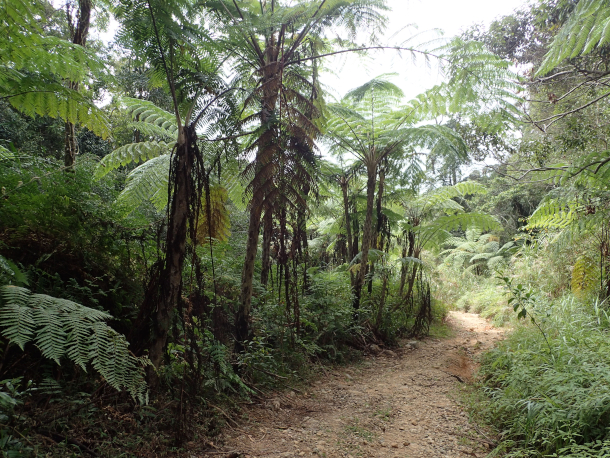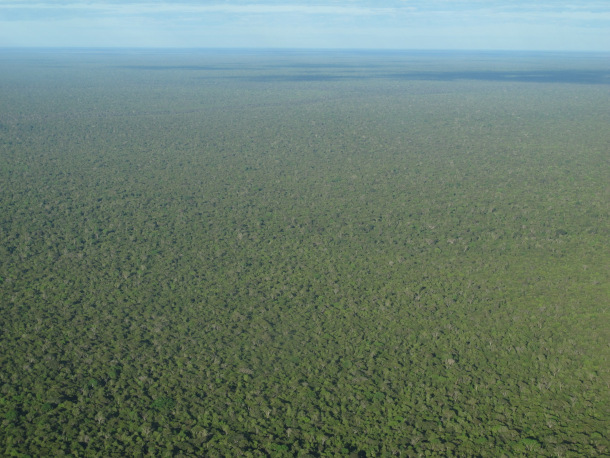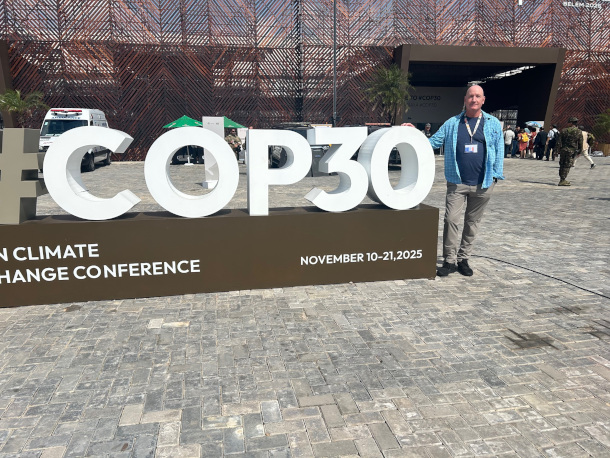Tropical Forests, Forever?
Air Date: Week of November 21, 2025

Tropical lowland forest in Mount Tupalao in the Philippines. About forty percent of the tropical forest in Southeast Asia has been lost due to deforestation and degradation. (Photo: Firth m, Wikimedia Commons, CC BY-SA 4.0)
As the host of this year’s UN climate treaty negotiations and home to most of the Amazon tropical rainforest, Brazil led a major advance for forests and their indigenous inhabitants called the Tropical Forest Forever Facility. The new $125 billion fund, with guarantees for investors, will send its profits to countries with documented forest preservation, including some cash going directly to indigenous and local populations. Michael Coe, a senior scientist at the Woodwell Climate Research Center who was at COP30, joins Hosts Steve Curwood and Jenni Doering to explain why forest protection is a vital piece of stabilizing the climate.
Transcript
DOERING: From PRX and the Jennifer and Ted Stanley studios at the University of Massachusetts Boston, this is Living on Earth. I’m Jenni Doering.
CURWOOD: And I’m Steve Curwood.
For the first time 30 years, Brazil was the host of the UN Climate Treaty negotiations known this year as COP 30. And it’s no surprise that the country with most of the Amazon tropical rainforest led a major advance for forests and their indigenous inhabitants.
DOERING: There have been other attempts to incentivize protecting forests, including carbon offsets, but these have been vulnerable to fraud and have had limited success. So, through the COP, Brazil, Norway and the Netherlands seeded a new $125 billion fund with guarantees for investors that will send its profits to countries with documented forest preservation, including some cash going directly to indigenous and local populations.
CURWOOD: For more on this critical ecosystem and the impact of the Tropical Forest Forever Fund or Facility, we called up Michael Coe who was at the COP in Belém Brazil. He is a Senior Scientist and tropical forest expert at the Woodwell Climate Research Center. Welcome to Living on Earth!
COE: Thank you very much, Stephen.
DOERING: So Mike, can you please give us a sense of the state of the world's forests, and especially tropical forests, at this moment? Where are they, and just how much of them have we lost?
COE: You know, there's three big blocks of tropical forest. It's in South America, Southeast Asia and the Congo. And when we think about really, over the last only few decades, a tremendous amount those have been lost. The greatest amount of loss is in Southeast Asia, where something like 40% have been removed. South America, something like 17%, and the Congo, about 20%. So in each of these regions over the last few decades, there's been significant loss of forest, and most of that, of course, is for agriculture.
CURWOOD: So Mike, tell us why tropical forests are so crucial. What's their role in the climate system and beyond?

Tropical forest in the Xingu Indigenous reserve in central Mato Grosso, Brazil. Tropical forests not only sequester carbon, they also act as planetary cooling “air conditioners” by pulling water from the soil and releasing it into the air as water vapor. (Photo: Michael Coe)
COE: They are really fascinating for the climate system. We think mostly about them in terms of their carbon. You know, they have an enormous amount of carbon in them, so when you deforest, you're emitting a great deal. But what I have been interested in, and what's really fascinating, is that that's not the only reason they're great for climate. Another big part is they are just giant air conditioners. What they do is pull water out of the soil from very deep down, and they evaporate it. And when they're photosynthesizing, they're evaporating water. And when you evaporate water, that's energy. You're taking heat, and you're converting water to vapor, and you're carting it away. So what they do is they cool the land surface enormously. And we see this throughout the tropics. If you deforest a parcel of land, it will almost immediately something like five degrees C warmer than the forest right next door, and that's on annual average. So if you walk out of the forest in the dry season, and you walk out onto an open field that is fallow, it is 10 degrees C hotter, 15 degrees C hotter. It is just astounding how much, and that's not just a local effect, but it has global implications.
DOERING: It's almost like the forest is able to sweat like we do.
COE: It's really exactly what it is. When it's photosynthesizing, it has to use that water to cool itself off. It's pulling in sunlight and it's getting hot. So that's exactly what it does.
CURWOOD: Well, just how much are deforestation and the degradation of forest adding to the climate emergency every year? I mean, compared to the burning of fossil fuels, what percentage of the problem are we looking at here?
COE: It's big. When you say tropical forest, it might be, say, 10% of all emissions, human emissions. If you talk all forest on the planet, probably 20% of all emissions. So deforestation is a big number. For many nations, it's by far the largest. And China's number one in emissions. US is number two. Deforestation is number three.

Deforestation in eastern Mato Grosso, Brazil. Deforestation of tropical forests, typically for agricultural purposes, is responsible for about 10% of all global emissions. (Photo: Michael Coe)
CURWOOD: And we talk about the carbon that it sequesters, but what about when you cut those trees down? How much carbon does it stop taking out of the air? What's the loss there and the effect on the climate?
COE: You know, that's a big number. You're talking about something like 15% of human emissions are being pulled back out by forests, by tropical forests. So yeah, it's a double loss. You're shutting off this ability to pull CO2 out of the atmosphere, and then you're just putting more back in. So it's a big loss.
CURWOOD: Wow. So at the end of the day, you have a 20% loss by cutting them down, and then you have another 20% loss of the forest pulling it out of the atmosphere?
COE: More or less, yes. I mean, that's what you're doing. You're shutting off your ability to pull it out, and you're emitting. So this is why, you know, some studies have shown that portions in the Amazon are now net emitters of CO2. Instead of net pulling it out, they're actually emitting more than they're pulling out, and that's because deforestation and the fires that are occurring.
DOERING: And by the way, I think we've been referring to deforestation, also to forest degradation. What does that actually mean?
COE: So forest degradation is when you still have the forest in place, but what you're doing is degrading how much carbon it has in it, basically how many trees.
CURWOOD: What leads to forests being so degraded, even if they're not completely cut down?
COE: The number one source of degradation in the tropics is fire. And the thing about fire, I can say this for sure in the Amazon and in Congo, in these dense, wet forests, fire is not natural. It doesn't occur like it does in the boreal forests, where lightning strikes and a huge fire occurs. That does not occur in the tropics. These are fires lit by people. So they're burning pasture to rejuvenate the grasses. They're doing slash and burn so they can open land to plant rice or whatever. And so in many ways, it is a problem that can be addressed. We know it's being caused by humans. And this is one of the things we try to work on a lot in Brazil in particular, is how do we reduce fires? The land is chopped up into chunks, and those edges now are really susceptible fire, and fire goes in there and takes out a large fraction. Once you've done that, it's a cycle. Now there's more sunlight coming in, it gets hotter, it's more susceptible to fire. And so it's a pretty slippery slope once you get started.
CURWOOD: And by the way, to what extent are those fires related to the warming planet itself?

Burning fields near Yangambi, Democratic Republic of Congo. Fire is the number one cause of degradation in tropical forests. (Photo: CIFOR-ICRAF, Flickr, CC BY-NC-ND 2.0)
COE: A great deal. And so last year was an incredible example. It was an El Niño year, which meant it was hotter, much hotter and drier. So when fires did start, they got huge. And it looks like last year, degradation committed as much CO2 to the atmosphere as deforestation did.
DOERING: Wow.
COE: So in most years, degradation's a significant number, but it's not as big as deforestation, you know. So it just essentially doubled the amount of CO2 emitted last year.
DOERING: And by the way, just how important are tropical forests to the Earth's temperature? I mean, if we cut down all tropical forests, what do you think would happen to the global average temperature?
COE: That's something we've been trying to quantify for a very long time, and recently, we did some experiments and put some work together, and we found that if you cut down all the tropical forests, every one, then the global temperature would probably rise by about one degree C, which is a large number. And what's really fascinating about that is half of that one degree C would be from all the emissions, the CO2 emissions, but the other half would be from that air conditioner that we broke. Those forests, as I mentioned before, they're an air conditioner, and they cool the planet. What's important here also to think about is okay, that means, if we deforest 10%, we raise the temperature by point one degrees C, which we really can't afford.
DOERING: Every tenth of a degree matters.
COE: Every one.
CURWOOD: So Michael, I know it's really hard to account for all of this, but it sounds like the problem with forests, tropical forests, them getting cut down and also being degraded, we're looking at a huge portion of the climate emergency. Looks like it's north of 30% or more that could be happening here.
COE: It's a big number. These forests are extremely important for our stable climate, and it’s one of the things we keep saying is they are going to mitigate some of the worst impacts of climate change occurring because of fossil fuels, and we are eliminating that, that incredible gift.

Brazilian President Luiz Inácio Lula da Silva (left) and UN Secretary-General António Guterres (right) attend the launch of the Tropical Forest Forever Facility. The TFFF is an investment fund designed to pay countries as well as local and indigenous persons for verified maintenance of their tropical forests. (Photo: Kiara Worth, UN Climate Change, Flickr, CC BY-NC-SA 4.0)
CURWOOD: So we're speaking to you at COP30 during its last days, and there's been a proposal led by Brazil for this Tropical Forest Forever Facility to fund, to pay to keep the trees. This is different from the question of money for carbon offsets, where money is given to countries to say, well, keep the trees from burning. In this case, they're talking about setting up, I don't know if it's a bank or an insurance policy that if a country shows that it hasn't cut its trees, it will get some money, very different. How can you police such a thing?
COE: It's going to depend on satellite observations of forest cover, because it has to be applied uniformly everywhere. We can't have independent agencies for every nation reporting. What we have to have is one tool that will tell us, and we all have to agree that that works.
DOERING: I mean, that seems like it could get tricky in terms of, what's the definition of healthy forest, and how do you tell if a forest, you know, has been slightly degraded, and then it starts being degraded more, and it, where's that tipping point, I guess, where's that, you know, slippery slope?
COE: That is tricky. And again, I think this TFFF has been, is being launched, and it's, I think it's a great idea. The devil will be in the details. And those details have not been worked out. You know, it's a process, and making those decisions on what constitutes full forest, et cetera, et cetera still have not been made.
DOERING: And by the way, what's in it for the people who are putting in money up front for this, what's the payout that they're going to receive?
COE: It's a fund, so it's going to be invested. And from my understanding, then that means that there's a certain rate that goes to the investors, and there's a certain amount then that is set aside to go to the nations to pay for their forest. You know, there's the positive of that is because now, if you're not buying a credit, other players, other investors can get involved, say pension funds or insurance companies who aren't necessarily interested in offsetting carbon, they're interested in making a profit. So it brings other actors into the forest conservation realm.

Forest ecologist Dr. Michael Coe is a Senior Scientist at the Woodwell Climate Research Center. He attended the COP30 climate talks in Belém, Brazil. (Photo: Sarah Moore)
CURWOOD: You know, it appears to me a unique aspect of this is it's talking about some percentage of these funds being paid directly to indigenous peoples and local communities. How big a deal is this?
COE: That's a big deal. Up to this point, it's been very difficult to find ways to include indigenous groups in the classic carbon credits, et cetera. So this whole idea is just very different. Instead of buying a credit, you're investing in a fund, and part of the profit of that fund goes to these nations for keeping forests in place, and part of that goes to people on the ground.
CURWOOD: So we know that this tropical forest fund is in its early stages. There seems to be 5 or maybe $7 billion committed at a seed level. How excited are you about the possibilities of this fund?
COE: I'm actually very excited. This is a significant amount of money. I think that the way it's structured will attract more investors. I think there's a real possibility here that this could fund significant conservation.
CURWOOD: So Mike, you're at COP30 right now. You've been going since the big meeting in Copenhagen back in 2009, and you've been in this business of climate research for a long time. What has the mood been like this year at the summit, and how are you feeling about the future?
COE: For me, this is, the mood here is wonderful. We've been trying for years to get forests, tropical forests in particular, as part of the agenda. Here in Brazil at COP30, they're really front and center. Forests are clearly an important part of our strategy. So for me, it's very positive. And you know, in terms of the future, I, it's a long slog we're on here. We have to keep trying, and we have to keep working and trying. This climate problem is not going to end tomorrow, and so these negotiations, these meetings, are extremely important.
DOERING: Dr. Michael Coe is a Senior Scientist at the Woodwell Climate Research Center.
CURWOOD: And he's been on the line with us from Belém in Brazil at COP30. Thank you so much for taking the time with us today, Mike.
COE: And thank you. It's been an absolute pleasure.
Links
Learn more about the Tropical Forest Forever Facility
Learn more about Dr. Michael Coe’s work
Learn more about the Woodwell Climate Research Center’s research on tropical forests
Living on Earth wants to hear from you!
Living on Earth
62 Calef Highway, Suite 212
Lee, NH 03861
Telephone: 617-287-4121
E-mail: comments@loe.org
Newsletter [Click here]
Donate to Living on Earth!
Living on Earth is an independent media program and relies entirely on contributions from listeners and institutions supporting public service. Please donate now to preserve an independent environmental voice.
NewsletterLiving on Earth offers a weekly delivery of the show's rundown to your mailbox. Sign up for our newsletter today!
 Sailors For The Sea: Be the change you want to sea.
Sailors For The Sea: Be the change you want to sea.
 The Grantham Foundation for the Protection of the Environment: Committed to protecting and improving the health of the global environment.
The Grantham Foundation for the Protection of the Environment: Committed to protecting and improving the health of the global environment.
 Contribute to Living on Earth and receive, as our gift to you, an archival print of one of Mark Seth Lender's extraordinary wildlife photographs. Follow the link to see Mark's current collection of photographs.
Contribute to Living on Earth and receive, as our gift to you, an archival print of one of Mark Seth Lender's extraordinary wildlife photographs. Follow the link to see Mark's current collection of photographs.
 Buy a signed copy of Mark Seth Lender's book Smeagull the Seagull & support Living on Earth
Buy a signed copy of Mark Seth Lender's book Smeagull the Seagull & support Living on Earth

